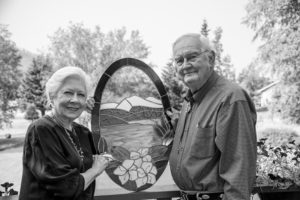This somewhat lengthy essay is a response to an article in a national publication. Your friendly blogger is not a memory support professional; my training in the area is extremely limited. This is a piece about ideas. Some of them are ideas that come from observation and from my limited training, but I’m not recommending any action to anyone, and neither is Immanuel Lutheran Communities or the Immanuel Foundation
The October 8, 2018 issue of The New Yorker features an article by Larissa MacFarquhar called “The Comforting Fictions of Dementia Care.” In it, MacFarquhar relates what she learned on a visit to The Lantern, a specialized memory support community in Chagrin Falls, Ohio, just east of Cleveland. The Chagrin Valley community features an interior that is decorated to look “much like the town outside.” The common spaces feature “facades of what looked like clapboard houses, with wooden shutters and shingled pitched roofs and porches that extended into the room. Two long hallways… looked like streets in the same town, with more clapboard facades and porches on either side.” Each “front door” opens onto a resident suite, offering the illusion that residents living in a locked community actually go outside every time they leave their suites.
The idea of illusion troubles MacFarquhar throughout the piece. As she traces the history of dementia care from the days of physical restraints and Haldol (an antipsychotic) to “Reality Orientation” treatments to current, kinder practices, she talks a lot about lying. By using that word, with all the value judgments it implies, and by making strong statements like “Family members and care staff lie all the time, and can’t imagine getting through the day without doing so, but, at the same time, lying makes many of them uncomfortable,” she poses a dichotomy between truth and lying that doesn’t necessarily exist where people with dementia are concerned.
Most memory support communities don’t take the illusion of external reality to the extent that The Lantern does (The Lodge at Buffalo Hill certainly doesn’t). However, many communities encourage staff and caregivers to “live in the reality” of the person with dementia. That means accepting their version of the world. If a family member talks about her deceased husband as if he’s still living, then, a lot of professionals would recommend talking about why he’s away rather than insisting that he’s dead. For professionals who recommend this course of action, these kinds of untruths are both kind and pragmatic. If your family member believes her husband to be alive, news of his death will alarm her—and likely, she’ll soon forget it again, requiring you to tell her over and over that her husband is no longer alive. This is likely to be extremely exhausting and unpleasant for both of you, so it’s something you might reasonably choose to avoid by going along with the fiction that her husband is simply absent.
The question, then—and MacFarquhar’s main concern—is whether going along with this fiction is lying. Admittedly, this is a tricky question. As MacFarquhar chronicles, people with dementia don’t necessarily want their family members and caregivers to tell them comfortable fictions. She includes a summary by British researcher Graham Stokes of a panel convened a few years ago to discuss ethical issues in dementia care. Stokes included people with dementia on his panel, and “All of them said, Why do you lie to us when we are at our most vulnerable? Would you wish your relationships with others to be based on deceit?” This is a fair point, and one that surely gives pause to many who interact regularly with people with dementia. Surely in determining best practices in memory support we have to take into consideration what those with dementia want. But the question becomes, What do you do if the person you’re interacting with believes you to be telling the truth when you are lying, and vise-versa? What is the difference between the truth—insofar as it’s possible to determine that objectively—and a truth for the person with dementia?
I don’t have the answers to these questions, and I don’t think anyone yet does. The memory support staff I know—and they range from managers to recreation staff to CNAs—believe in making every day as positive an experience as possible. They certainly don’t set out to deceive the residents they care for, but if a resident believes she’s on a train, they’ll play the role of conductor. Their training and their kind hearts tell them that the best thing to do for the resident is to enter their reality. By being a train conductor for a little while, a staff member likely helps a resident have a much better day than she would if the staff member said, “Nope, I’m a CNA and you’re not going anywhere except to the TV room.”
In his essay “On Truth and Lies in a Nonmoral Sense,” German philosopher Friedrich Nietzsche posits, “What men avoid by excluding the liar is not so much being defrauded as it is being harmed by means of fraud. Thus… what they hate is basically not deception itself, but rather the unpleasant, hated consequences of certain sorts of deception.” As a scholar I’m compelled to note here that this essay is mostly about metaphor and language and how we as humans construct the world, but Nietzsche’s ideas are nonetheless useful here. When a memory support staff member takes on the role of train conductor, she might in an objective sense be deceiving the resident in question. But the resident is probably happier in this case “being defrauded” than she would be otherwise, and she’s not harmed by the “fraud” in any concrete sense. There aren’t really any negative consequences here, except in the most abstract sense. In fact, I’d go so far to say that it’s not really fraud, because fraud implies intent.
MacFarquhar concludes her article with a description of a Dutch community built to look like “a modern neighborhood in a Dutch city.” It includes a restaurant, a pub, a café, a supermarket, a small mall, and even a music performance venue. While the residents cannot leave, some parts of the community, like the restaurant, are open to the public. MacFarquhar never says out right that this community lies, and she even seems to admire its homelike atmosphere and philosophy of public engagement. However, her description immediately follows dire warnings about the consequences of lying. Just before embarking on her description of the Dutch community, she quotes philosopher Sissela Bok: “The veneer of social trust is often thin… As lies spread… trust is damaged. Yet trust is a social good to be protected just as much as the air we breathe or the water we drink… When it is destroyed, societies falter and collapse.” In many senses, everything about the Dutch community is a lie. Residents do not actually purchase things at the supermarket, and their homes are not in a normal neighborhood. But could such deception really lead to the collapse of society?
I don’t think so, and as you can probably tell, I was, well, bugged by this article. I value honesty in my interactions, but I can’t honestly say that if I were to develop dementia I would want everyone around me to tell the objective truth, regardless of the consequences for my well-being on any given day. It should be up to every individual to make that decision, but as MacFarquhar rightly notes, it can be very hard to know with regard to dementia whether an individual’s desires remain the same. What we do know is that while people with dementia might not experience what we would consider the objective truth, they have experiences that are real to them. By watching and listening to them, we can get a little bit of access to their truths, and that’s probably more than they can get to ours.
All of my colleagues want to be ethical (as do I), and “tell the truth” seems like the most basic part of ethical practice as a professional and as a human being. But maybe in memory support, ethics mean something else. Maybe they mean respecting the truth of the person you’re working with, whatever it happens to be on the day. Maybe it simply means, as I know my colleagues over in memory support do every day, creating a here-and-now for people with dementia that respects who they are at this particular moment. I think this is what MacFarquhar is struggling with throughout the article, and again, I don’t have the answers. But I don’t think it’s as simple as truth and lies.


 Villas residents Fred and Shelby Thompson aren’t from northwest Montana, but they love it here. In their photo, you can see a stained glass piece they made together that symbolizes their two homes: Montana, symbolized by Glacier National Park’s Lake McDonald, and Alabama, symbolized by a pink camellia. They first came to Glacier nearly fifty years ago. On that first trip in 1969, the couple decided they would eventually move to Glacier Park, and decision that came to fruition when they built their first West Glacier house in 1997. Both still speak with gentle, light Southern accents, but it’s clear from their West Glacier home (where we met them this past August) that they’ve put down roots in Montana.
Villas residents Fred and Shelby Thompson aren’t from northwest Montana, but they love it here. In their photo, you can see a stained glass piece they made together that symbolizes their two homes: Montana, symbolized by Glacier National Park’s Lake McDonald, and Alabama, symbolized by a pink camellia. They first came to Glacier nearly fifty years ago. On that first trip in 1969, the couple decided they would eventually move to Glacier Park, and decision that came to fruition when they built their first West Glacier house in 1997. Both still speak with gentle, light Southern accents, but it’s clear from their West Glacier home (where we met them this past August) that they’ve put down roots in Montana.